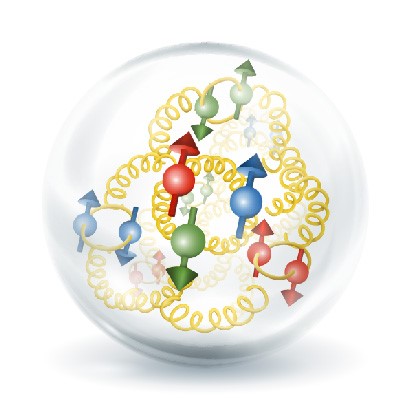EIC Center at Jefferson Lab
The Electron-Ion Collider Center at Jefferson Lab (EIC2@JLab) is an organization to advance and promote the science program at a future electron-ion collider (EIC) facility. Particular emphasis is on the close connection of EIC science to the current Jefferson Lab 12 GeV CEBAF science program.
 At the heart of the atom are protons and neutrons. The characteristics and interactions of neutrons and protons, singly and collectively in the nuclei are responsible for how our cosmos developed and how our sun provides the heat that sustains the eco-system on earth.
At the heart of the atom are protons and neutrons. The characteristics and interactions of neutrons and protons, singly and collectively in the nuclei are responsible for how our cosmos developed and how our sun provides the heat that sustains the eco-system on earth.
While we have known for 50 years that protons and neutrons are made of quarks and gluons (represented in the figure to the left as spheres with arrows and springs, respectively), we are just beginning to learn how to image the structure and interactions inside protons and neutrons that are at the femto-scale, a million times smaller than the nano-scale of modern micro-electronics.
Jefferson Lab has been at the forefront of this research; the current 12 GeV CEBAF program at JLab is world-leading in this science. The proposed Electron-Ion Collider will be the ultimate instrument for this new science: nuclear femtography.
- October 2015- The Nuclear Science Advisory Committee provided its recommendations on future priorities for the field of nuclear physics, including a long-range plan recommendation to build an EIC.
- July 24, 2018- The National Academy of Sciences issued it's assessment of the U.S.-Based Electron-Ion Collider Science. The report is available here.
- January 9, 2020- The US Department of Energy selects Brookhaven National Lab as the site for the collider, with Jefferson Lab as a major partner.
- March 8. 2021- The Yellow Report on the EIC detector requirements https://arxiv.org/abs/2103.05419 is published online.
More detailed information about the Electron-Ion Collider can be found at the following links:
NEWS:
JLab News: Nuclear Science Advisory Committee Issues Plan for U.S. Nuclear Physics Research



